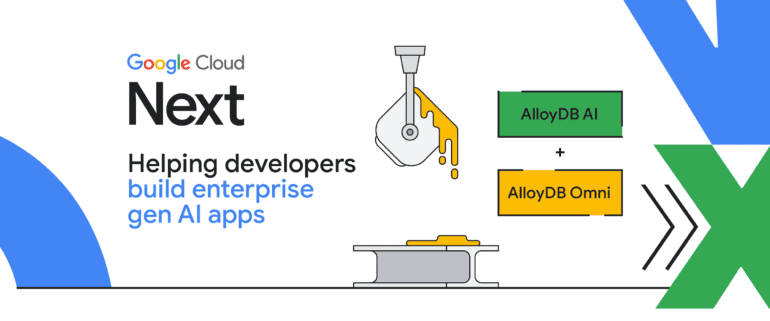TL;DR:
- Google introduces AlloyDB AI, enhancing PostgreSQL with generative AI capabilities.
- Developers can seamlessly integrate large language models (LLMs) with real-time data.
- Support for vector embeddings and similarity searches in managed databases.
- AlloyDB AI offers faster vector support and quantization techniques.
- Access to local and remote AI models for fine-tuning and deployment.
- Integration with the AI ecosystem, including Vertex AI Extensions.
- Expert’s viewpoint: Enhancements reflect Google’s commitment to innovation in the PostgreSQL market.
Main AI News:
In a recent unveiling at Google Cloud Next, Google introduced AlloyDB AI as a pivotal component within AlloyDB for PostgreSQL, ushering in a new era of generative Artificial Intelligence (AI) applications. This innovative solution empowers developers to harness the capabilities of large language models (LLMs) and seamlessly integrate them with real-time operational data, all while benefiting from built-in, end-to-end support for vector embeddings.
Previously, Google had already rolled out support for pgvector on Cloud SQL for PostgreSQL and AlloyDB for PostgreSQL, making vector search operations readily available for managed databases. This enabled developers to store vector embeddings generated by Large Language Models (LLMs) and conduct similarity searches effortlessly. AlloyDB AI builds upon the existing vector support offered by standard PostgreSQL, equipping developers with the prowess to craft and execute embeddings-based queries, all without the need for a specialized data stack or data migration.
Beyond these fundamental enhancements, AlloyDB AI introduces several other cutting-edge capabilities that can empower developers to seamlessly incorporate real-time data into their generative AI applications:
- Enhanced Vector Support: AlloyDB AI offers faster vector support compared to conventional PostgreSQL queries, thanks to its seamless integration with the AlloyDB query processing engine. Additionally, Google has incorporated quantization techniques rooted in its ScaNN technology, enabling support for four times more vector dimensions while reducing storage requirements by threefold when activated.
- Access to Local and Remote Models: Developers can access both local models within AlloyDB and remote models hosted on Google Cloud’s Vertex AI platform. This includes the flexibility to work with custom models or leverage pre-trained ones. Developers can train and fine-tune models using data stored in AlloyDB and subsequently deploy them as endpoints on Vertex AI.
- AI Ecosystem Integrations: AlloyDB AI seamlessly integrates with the wider AI ecosystem, including forthcoming Vertex AI Extensions and LangChain. These integrations pave the way for calling remote models hosted on Vertex AI, enabling low-latency, high-throughput augmented transactions using SQL. This functionality can prove invaluable for applications such as fraud detection.
Andi Gutmans, General Manager and Vice President of Engineering at Google Cloud Databases, highlighted these advancements in a blog post, emphasizing how AlloyDB AI simplifies the process of converting data into vector embeddings through a straightforward SQL function for in-database embedding generation. Furthermore, it accelerates vector queries, delivering speeds up to 10 times faster than standard PostgreSQL. This, coupled with seamless integrations with the open-source AI ecosystem and Google Cloud’s Vertex AI platform, presents a holistic solution for constructing generative AI applications.
Regarding concerns about Google’s intentions, one Reddit user noted that enhancing and integrating popular open projects does not necessarily signify an Embrace, Extend, and Extinguish (EEE) strategy. They pointed out that these actions often stem from a desire to enhance product value and streamline resource allocation. In the case of Google, the focus may be on improving features and optimizing resource allocation rather than an EEE approach.
It’s worth noting that other database and public cloud providers also offer support for vector embeddings, including MongoDB, DataStax’s Cassandra database service Astra, open-source PostgreSQL (via Pgvector), and Azure Cognitive Search, which recently introduced a new capability for indexing, storing, and retrieving vector embeddings from a search index during its preview phase.
Lastly, AlloyDB AI is readily available within AlloyDB on Google Cloud and AlloyDB Omni, all without incurring additional costs. This democratizes access to advanced AI capabilities for developers and organizations, further solidifying Google’s commitment to fostering innovation within the PostgreSQL ecosystem.
Conclusion:
Google’s AlloyDB AI marks a significant step forward in the PostgreSQL market. By empowering developers with advanced vector embeddings and seamless AI integration, it not only streamlines the development of generative AI applications but also positions Google as a leader committed to innovation within the PostgreSQL ecosystem. This development is likely to drive further advancements and competition in the market, benefitting developers and organizations seeking to leverage AI capabilities in their database solutions.

